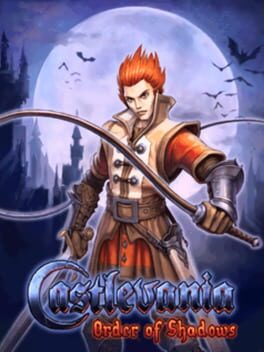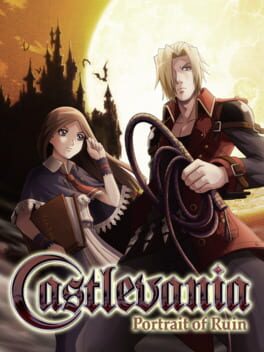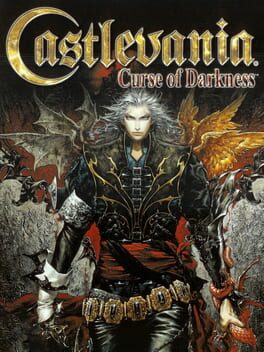

Draw the correct magic seal quickly, or your enemies will never die! Fight and explore through one of the largest castles ever seen in the series! Race another player through custom-made castle rooms in versus mode! A year has passed since Soma Cruz discovered the evil of Dracula hidden inside his body. Now, a mysterious cult wants to release the power of the Lord of Darkness. As Soma, you must do everything in your power to stop them before it's too late.
Also in series
Reviews View More
Mandando a real, Dawn of Sorrow ficou pau a pau com Symphony of the Night no quesito de ser o melhor Castlevania que eu joguei até agora - a nível de eu ter animado fechar ele com 100% do mapa e das almas.
...mas, por fatores mínimos de desempate, SotN ainda está em 1° lugar.
Alias, pequena curiosidade divertida: o Dawn of Sorrow é o primeiro Castlevania que não se passa no Castlevania (para os que não sabem, Castlevania é literalmente o nome do castelo do Drácula).
Comparado ao Aria of Sorrow, o nível de melhoria aqui foi magnífico - o que não é surpresa, visto que o Aria é de GBA e o Dawn é de DS. Resumidamente, temos aqui um Aria com o mesmo nível de qualidade de gameplay que o SotN. Tudo está mais fluido, mais bonito e mais divertido.
Assim como em Aria, o jogo possui uma dificuldade um pouco mais alta para te incentivar a caçar almas e ser criativo usando elas. Os poderes das almas variam bastante e sempre dá para pensar em combos interessantes para lutar contra certos inimigos e bosses.
A gameplay ainda possui alguns errinhos, como a luta contra alguns poucos bosses que possuem movimentação bem quebrada (sério, vai se ferrar quem programou o Gergoth! O bicho ficava pulando em mim e entrando na parede o tempo inteiro!) mas nada que quebre a diversão geral da experiência do jogo.
A única coisa que me deixou triste é terem trocado o visual dos personagens para um estilo anime - que nem de longe é ruim (é até bem simpático), mas sejamos sinceros, o estilo gótico das artes da Ayami Kojima, que a série tinha até então, era simplesmente incomparável! Tanto que, até hoje, quando se pensa em Castlevania, se pensa nas artes da Ayami Kojima.
E falando de questões artísticas, as músicas e especialmente os visuais do Dawn são ótimos. Boa parte dos designs de inimigos voltaram para o estilo do SotN, e, seguindo essa mesma base, muitos bosses foram feitos em estilos mais tenebrosos, o que ficou muito bom.
Ah, e também, por ser um jogo de DS, ele possui algumas interações com a tela touch, como o sistema de desenhar selos mágicos, que dá pra perceber claramente que é uma mecânica extra feita só pra não deixar a tela touch de fora. Mas confesso que, mesmo sendo algo totalmente desnecessário e descartável, eu achei até que bem divertidinho de fazer o minigame dos selos conforme ele vai ficando mais complexo.
Vou ser sincero, não sei como nunca tinha ouvido falar do Dawn até pouco tempo, sendo que ele é bem melhor que o Aria em quase todos os aspectos (e o Aria eu escutava sobre em todo lugar).
Se você gostou do Aria, com toda a absoluta certeza você vai gostar do Dawn também! E se você não jogou nenhum dos dois, comece pelo Aria para poder entender bem todos os aspectos da gameplay, história e personagens, pois há muita coisa diretamente conectada no Dawn.
...mas, por fatores mínimos de desempate, SotN ainda está em 1° lugar.
Alias, pequena curiosidade divertida: o Dawn of Sorrow é o primeiro Castlevania que não se passa no Castlevania (para os que não sabem, Castlevania é literalmente o nome do castelo do Drácula).
Comparado ao Aria of Sorrow, o nível de melhoria aqui foi magnífico - o que não é surpresa, visto que o Aria é de GBA e o Dawn é de DS. Resumidamente, temos aqui um Aria com o mesmo nível de qualidade de gameplay que o SotN. Tudo está mais fluido, mais bonito e mais divertido.
Assim como em Aria, o jogo possui uma dificuldade um pouco mais alta para te incentivar a caçar almas e ser criativo usando elas. Os poderes das almas variam bastante e sempre dá para pensar em combos interessantes para lutar contra certos inimigos e bosses.
A gameplay ainda possui alguns errinhos, como a luta contra alguns poucos bosses que possuem movimentação bem quebrada (sério, vai se ferrar quem programou o Gergoth! O bicho ficava pulando em mim e entrando na parede o tempo inteiro!) mas nada que quebre a diversão geral da experiência do jogo.
A única coisa que me deixou triste é terem trocado o visual dos personagens para um estilo anime - que nem de longe é ruim (é até bem simpático), mas sejamos sinceros, o estilo gótico das artes da Ayami Kojima, que a série tinha até então, era simplesmente incomparável! Tanto que, até hoje, quando se pensa em Castlevania, se pensa nas artes da Ayami Kojima.
E falando de questões artísticas, as músicas e especialmente os visuais do Dawn são ótimos. Boa parte dos designs de inimigos voltaram para o estilo do SotN, e, seguindo essa mesma base, muitos bosses foram feitos em estilos mais tenebrosos, o que ficou muito bom.
Ah, e também, por ser um jogo de DS, ele possui algumas interações com a tela touch, como o sistema de desenhar selos mágicos, que dá pra perceber claramente que é uma mecânica extra feita só pra não deixar a tela touch de fora. Mas confesso que, mesmo sendo algo totalmente desnecessário e descartável, eu achei até que bem divertidinho de fazer o minigame dos selos conforme ele vai ficando mais complexo.
Vou ser sincero, não sei como nunca tinha ouvido falar do Dawn até pouco tempo, sendo que ele é bem melhor que o Aria em quase todos os aspectos (e o Aria eu escutava sobre em todo lugar).
Se você gostou do Aria, com toda a absoluta certeza você vai gostar do Dawn também! E se você não jogou nenhum dos dois, comece pelo Aria para poder entender bem todos os aspectos da gameplay, história e personagens, pois há muita coisa diretamente conectada no Dawn.
In my continued quest to play any Castlevania games I could reasonably get my hands on, I was trepidatious to see how the DS outings faired against the GameBoy Advance titles. Though they were mixed in overall quality, the GBA Castlevania trilogy ended with a bang with Aria of Sorrow; the most fleshed-out and fun experience the handheld had to offer. Truly the first Castlevania experience that felt as if it was building off of Symphony of the Night, rather than chasing up to its lofty reputation.
Unfortunately, the momentum of Aria of Sorrow would not be fully carried into Dawn of Sorrow: an entertaining affair with several improvements over its predecessor, but helms an equal number of regressions, too. The first true benefit gained with the extra buttons and dual-screen layout of the DS is Dawn's ability to swap between loadouts and map/enemy information with a simple button press. Though there is still a hefty amount of menu navigation required in Dawn, the severity of it is lessened when you can easily swap between two completely different builds on the fly to accommodate any situation you encounter. Looking at the map and the player's RPG progression on the top screen is an additional blessing, severely cutting down time wasted in menus when you're lost and have no clue where to go next. In terms of QOL features present in a Castlevania title, Dawn is easily the most accessible as simply getting around the map is significantly faster than before.
Aria of Sorrow's "Tactical Soul System" is retained and fleshed out further in Dawn, with multiple equipment slots before considering the loadout swaps. The player can have six different souls equipped, with many of them feeling useful to some degree. As the game progresses, many will inevitably regress in usefulness, but the strong souls remain strong, greatly enhancing combat and traversal effectiveness.
For every step forward Dawn of Sorrow takes, it takes one back. While the game feels smoother and easier to play than prior entries, it also forces in obnoxious touch controls that take some time to get used to. Thankfully, touch controls are a rarity, but they tend to prop up in obnoxious ways, usually due to timing. Having to remove ice by tapping the screen while on a moving platform, or drawing a pattern to confirm the boss's death is "whatever" at best, and frustrating at worst. As many players have complained before, deaths due to a failed magic seal pattern are infuriating and can potentially reset a significant amount of progress. Thankfully, an option in the in-game menu to practice drawing the seals is considerate, but their exclusion would have ultimately made the game better.
The magic seals are only some of the bloat in Dawn of Sorrow. Attempting to attain the "true" ending is a frustrating trial-and-error process if you're not consulting online walkthroughs. Even when on the correct path for the true ending, the last few areas and bosses feel like a drag to get to the finish; a prime "I was having fun... until I wasn't" ordeal. While I still trucked through for Dawn of Sorrow (mostly out of guilt for not finishing a 3D Castlevania, yet), I almost wish I didn't as to not sour the experience, but a bad ending should be called out as such.
When looking at where Dawn of Sorrow fits in the greater lexicon of Castlevania titles, it stands on its own with many original ideas and improvements to the formula. Sadly, there are enough regressions in the gameplay and a horrific art style change to make Dawn of Sorrow feel like it isn't living up to its full potential.
Unfortunately, the momentum of Aria of Sorrow would not be fully carried into Dawn of Sorrow: an entertaining affair with several improvements over its predecessor, but helms an equal number of regressions, too. The first true benefit gained with the extra buttons and dual-screen layout of the DS is Dawn's ability to swap between loadouts and map/enemy information with a simple button press. Though there is still a hefty amount of menu navigation required in Dawn, the severity of it is lessened when you can easily swap between two completely different builds on the fly to accommodate any situation you encounter. Looking at the map and the player's RPG progression on the top screen is an additional blessing, severely cutting down time wasted in menus when you're lost and have no clue where to go next. In terms of QOL features present in a Castlevania title, Dawn is easily the most accessible as simply getting around the map is significantly faster than before.
Aria of Sorrow's "Tactical Soul System" is retained and fleshed out further in Dawn, with multiple equipment slots before considering the loadout swaps. The player can have six different souls equipped, with many of them feeling useful to some degree. As the game progresses, many will inevitably regress in usefulness, but the strong souls remain strong, greatly enhancing combat and traversal effectiveness.
For every step forward Dawn of Sorrow takes, it takes one back. While the game feels smoother and easier to play than prior entries, it also forces in obnoxious touch controls that take some time to get used to. Thankfully, touch controls are a rarity, but they tend to prop up in obnoxious ways, usually due to timing. Having to remove ice by tapping the screen while on a moving platform, or drawing a pattern to confirm the boss's death is "whatever" at best, and frustrating at worst. As many players have complained before, deaths due to a failed magic seal pattern are infuriating and can potentially reset a significant amount of progress. Thankfully, an option in the in-game menu to practice drawing the seals is considerate, but their exclusion would have ultimately made the game better.
The magic seals are only some of the bloat in Dawn of Sorrow. Attempting to attain the "true" ending is a frustrating trial-and-error process if you're not consulting online walkthroughs. Even when on the correct path for the true ending, the last few areas and bosses feel like a drag to get to the finish; a prime "I was having fun... until I wasn't" ordeal. While I still trucked through for Dawn of Sorrow (mostly out of guilt for not finishing a 3D Castlevania, yet), I almost wish I didn't as to not sour the experience, but a bad ending should be called out as such.
When looking at where Dawn of Sorrow fits in the greater lexicon of Castlevania titles, it stands on its own with many original ideas and improvements to the formula. Sadly, there are enough regressions in the gameplay and a horrific art style change to make Dawn of Sorrow feel like it isn't living up to its full potential.





